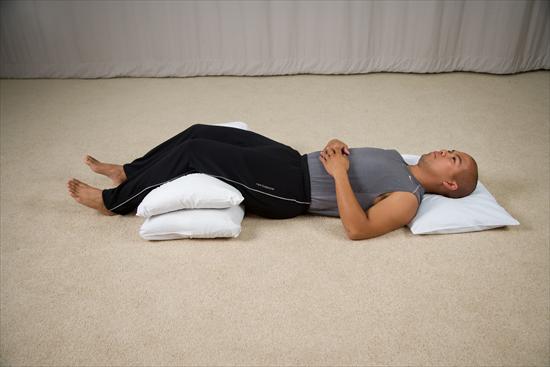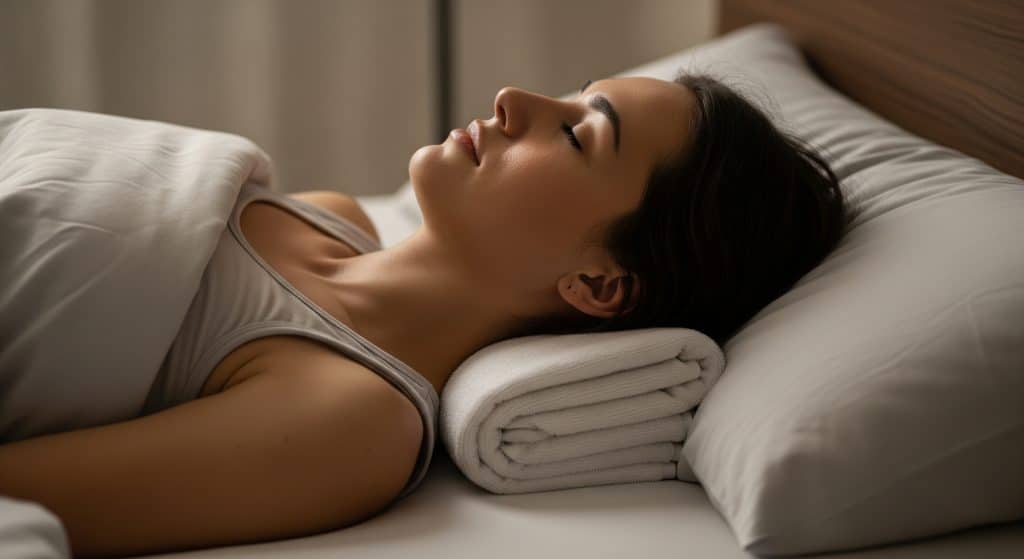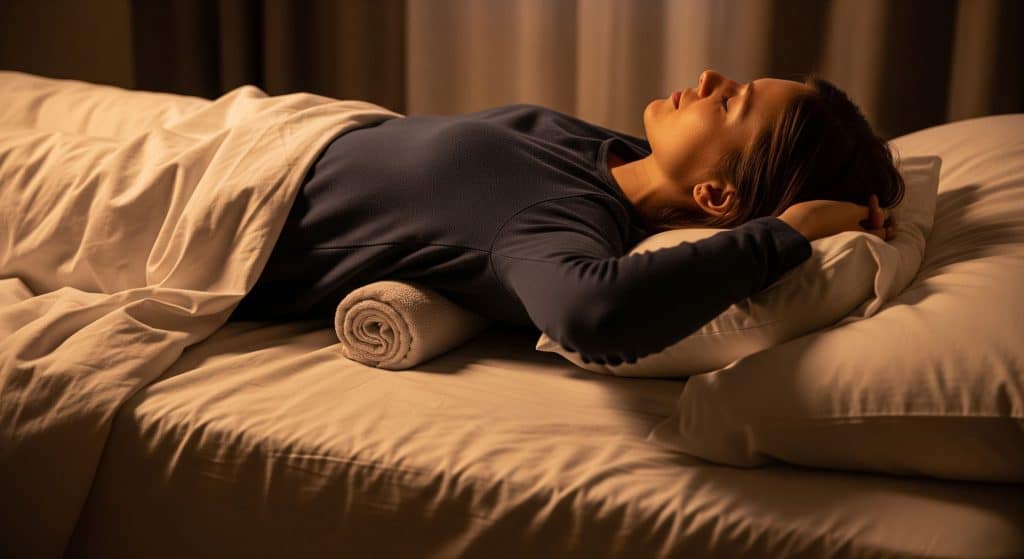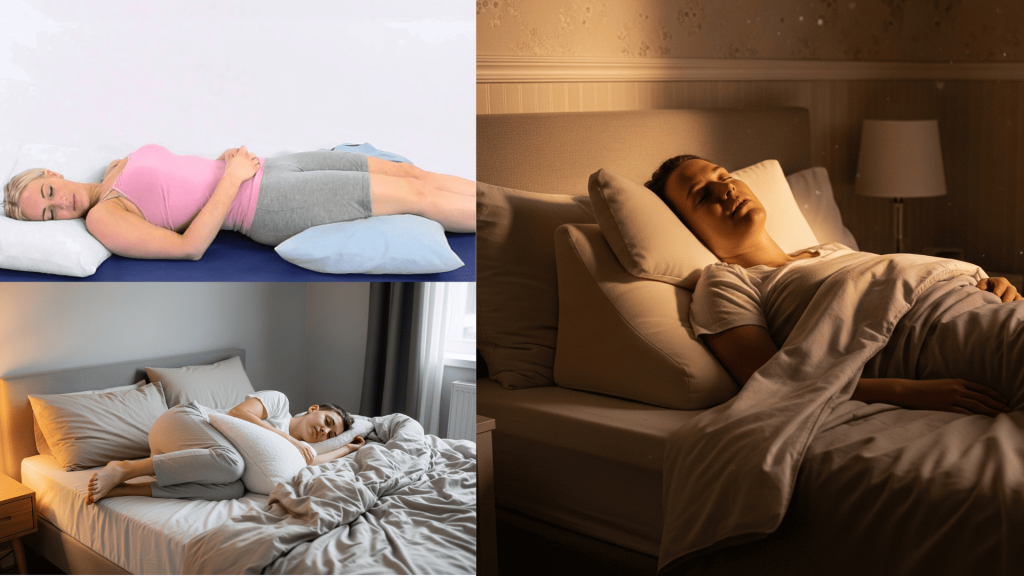Tired of your back keeping you up all night? That nagging pain between your shoulder blades can ruin your sleep.
Sometimes, it’s a thoracic herniated disc, when one of the soft cushions in your mid-back slips out of place and presses on a nerve.
The way you sleep can make a big difference. Some positions ease the pressure and help you heal, while others can make things worse.
In this guide, you’ll learn how to sleep with a thoracic herniated disc, the best sleeping positions, how to set up your bed, and simple tricks to help you rest better. It’s not complicated, but it could finally get you sleeping through the night.
What is a Thoracic Herniated Disc
Your thoracic spine is the middle part of your back, the bones that run from your neck to your lower back, right where your ribs connect. Think of it like your body’s frame that keeps you standing up straight.
Between each bone sits a soft, squishy disc that works like a cushion. A thoracic herniated disc happens when one of these cushions gets squished and pokes out.
This usually comes from things like getting hurt in sports, lifting heavy stuff, or slouching too much at your computer.
You’ll feel sharp or burning pain between your shoulder blades. Sometimes it travels around to your chest, too. Here’s the key: how you sleep can make this pain much worse or help it get better.
How to Sleep with a Thoracic Herniated Disc
Finding the right sleeping position can be a game-changer when you’re dealing with thoracic disc pain. Here are five positions that work for most people:
1. Back Sleeping with Pillow Under Knees

Sleeping on your back is like giving your spine a break. It keeps everything straight and takes pressure off your hurt disc.
Stick a pillow under your knees so they bend a little; this helps your whole back relax. Don’t use a huge pillow for your head, just enough so your neck feels normal, not pushed up or hanging down.
2. Side Sleeping with Pillow Between Knees

Roll onto your side and squeeze a pillow between your knees. This keeps your hips even and stops your back from twisting while you sleep.
Pick whichever side feels better, usually the one that doesn’t hurt more. Make sure your head pillow keeps your neck straight, not bent up or down like you’re looking at the ceiling or floor.
3. Sleeping Propped Up

Sometimes sleeping a little upright feels way better. Use a wedge pillow or prop up your bed so you’re sleeping at a slight angle.
This takes some weight off your middle back and can help if your disc pain makes it hard to breathe. Try this if sleeping flat makes you toss and turn all night.
4. Stomach Sleeping (Sometimes Okay)

Most doctors say sleeping on your stomach is bad, but some people with back disc problems actually feel better this way.
If other positions hurt too much, try putting a thin pillow under your belly to keep your back from sagging. Turn your head to whatever side feels more comfortable. Only do this if nothing else works.
5. Curled Up Like a Ball

Lie on your side and curl up, but don’t squeeze too tightly. Put a pillow between your knees and maybe hug another one.
This makes more space between the bones in your back and gives your disc room to breathe. Just don’t curl up so much that you wake up feeling stiff and creaky.
Pillow Placement Tips for Added Support
Sometimes, simply moving a pillow to the right spot can significantly improve your back’s comfort while you sleep.
Under the Shoulders or Upper Back

Try putting a thin pillow or rolled-up towel under your shoulder blades when you’re on your back. This opens up your chest a bit and gives your middle back a break. It’s like getting a gentle stretch while you sleep.
Don’t use anything too thick; you want just enough to feel good, not like you’re trying to bend backwards all night long.
Small Roll Under Mid-Back

Put a small pillow or rolled towel right under your middle back to help keep your spine’s normal curve. This helps when you’re on your back and your middle back feels too flat against the bed.
The roll should be about as thick as your arm, big enough to help, but not so big that it pushes your back into a weird spot that hurts.
Sleeping Positions to Avoid
Some sleeping positions might feel comfortable at first, but they can make your disc pain worse overnight.
- Standard Stomach Sleeping: Lying on your stomach twists your neck and puts extra pressure on your mid-back, which can make pain worse over time.
- Fetal Position Curl: Curling up too tightly bends your spine more than it should, adding pressure that may irritate nerves.
- Twisted Side Sleeping: When your shoulders twist but your hips stay forward, it strains your back muscles and joints.
Avoid these positions to wake up fresh and comparatively pain-free.
Additional Pain-Management Tips for Better Sleep

I’ve found that a few small changes to bedtime routine can make a huge difference in how your back feels at night.
Pre-Bedtime Stretching and Mobility Work. Doing gentle back stretches or simple yoga moves can loosen tight muscles and take pressure off your mid-back.
Just a few minutes before bed can help you feel more comfortable, fall asleep faster, and wake up with less pain in the morning.
Heat or Cold Therapy Before Bed. Use a warm pack to relax stiff muscles, or try a cold pack to bring down swelling and numb, sharp pain. Go with what feels better for you.
Doing this before bed can make your back feel calmer and help you rest through the night without as much discomfort.
Consistent Sleep Schedule. Going to bed and getting up at the same time each day teaches your body when to rest.
This helps you fall asleep easier, stay asleep longer, and get better-quality rest. Good sleep also gives your body the time it needs to heal and feel better.
Give these simple habits a try and see how much easier it is for you to get comfortable, sleep better, and wake up feeling good.
When to See a Doctor or Physical Therapist
If you have weakness, numbness, or pain that’s strong even when you’re resting, don’t ignore it. These symptoms could mean there’s something more serious going on with your back.
A doctor or physical therapist can find out exactly what’s wrong and create a plan that’s right for you. They can guide you through safe movements, gentle stretches, and simple exercises that help reduce pain and speed up healing.
You might also get advice on posture, daily habits, and ways to avoid making the injury worse.
Getting help early not only makes recovery easier but also helps you sleep better, move with less discomfort, and get back to your normal activities sooner without worrying about more damage.
Conclusion
I’ve learned that the right sleep position and good support can make a huge difference with mid-back pain.
You now know how to sleep with a thoracic herniated disc, what to avoid, and how small changes, like using pillows the right way, can ease pressure.
I tried different setups until I found what feels best for my body. If you’re thinking about big changes to how you sleep with a thoracic herniated disc, check with your doctor first. The goal is to rest in a way that helps you heal and wake up feeling better.
If you want more simple tips for sleep and comfort, take a look at my other blogs; you might find the next thing that really works for you.









